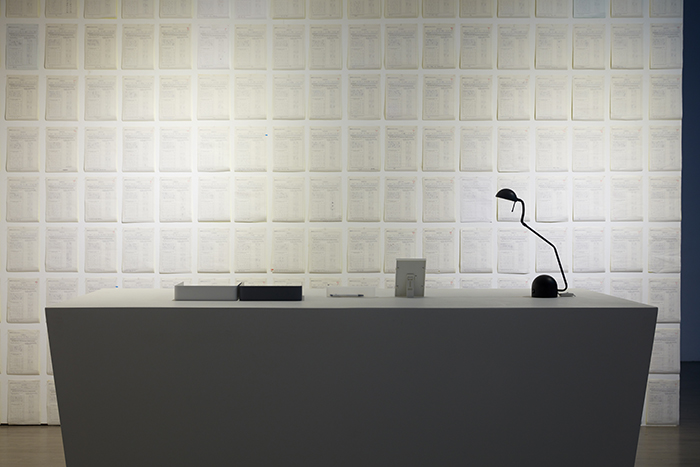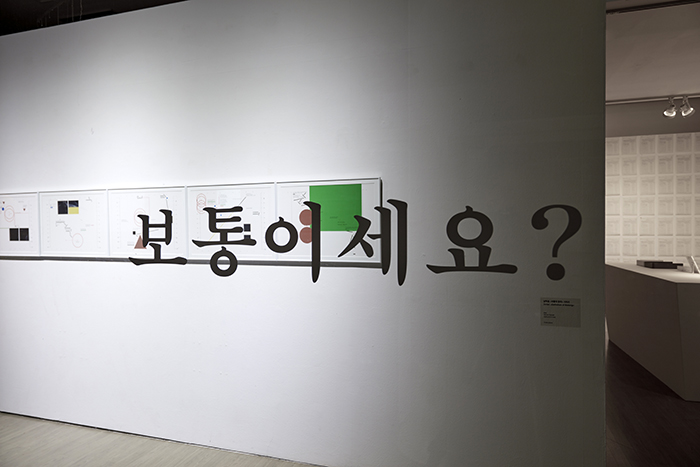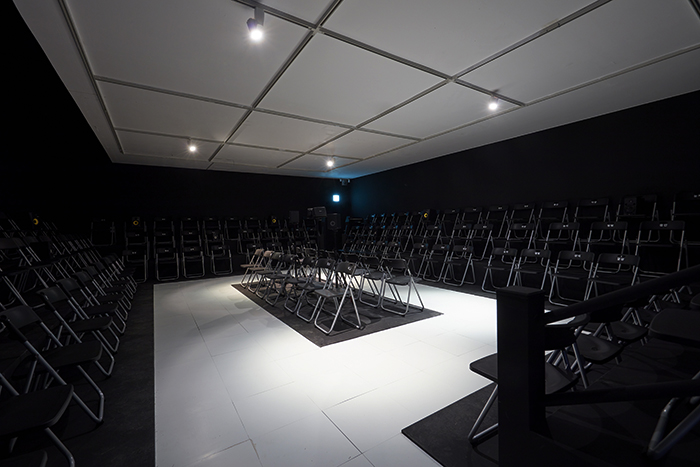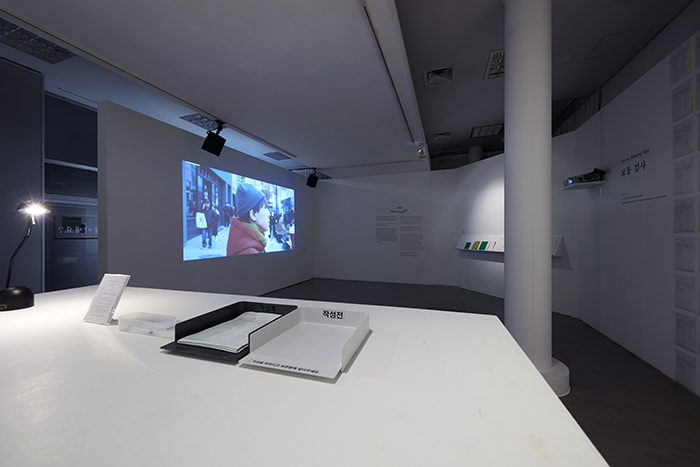Cho Juhyun | Chief curator, Ilmin Museum of Art
Over the last ten years, Park Hyesoo has visualized the collective memory and unconsciousness of Korean society under a neoliberal system and the “things lost, values damaged and lost” in daily life of each individual. Park usually works in such a way that kicks off by asking viewers questions to draw stories from them or to make them act and collect the data. Thus, the method of engaging the audience in the exhibition matters, and the artist has invented a series of special art devices such as one in the form of survey like psychological test, consultation with psychiatrist or tarot fortune teller, typewriter typing, or narration stage setting. These devices carry the unique experiences of the artist and audience and their communities. As each individual's life permeates into the exhibition hall and artworks are directly intervened with their life, the devices create a bond of sympathy with the thoughts and lives of neighbors and strangers in the audience without their knowing it and enable people to participate in the active dialog. Outlined herein are ten undertones inferred from the formal characteristics of ten keywords composing Definition of Botong (2013 - 2018), Park’s dialogue project.

Survey 'Test Botong'_2018
[1] “Are You Botong?”
The plain and ordinary question “Are you botong[1]?” has been asked for six years from 2013 to 2018 to anonymous audience who came to the exhibition. Definition of Botong is a platform where countless people virtually coexist over time. Here, “dialog” itself functions as an artwork. The project began by conducting “Test Botong,” a psychological test-type survey, among approximately 3,000 beholders and collecting and studying the responses. It sought to find out the impact of the standard and definition of Botong that Korean society accords to its individuals on their lives and communities. In other words, the focus is on the social role of art, which functions as a type of forum for public opinion to question whether the “range of normality” accepted in this society is normal indeed. The artist, who volunteered to take on the role of “investigator” in this process, collected the data of age groups and classes in order to garner different opinions as much as possible and analyzed the social symptoms in collaboration with a psychiatrist using the collected data. Park then attempted her own artistic interpretation and intervention to the consequent results, and she has raised, developed, and improved the platform into different phases including dialog archive, installation, poetry, play, performance, video, and so on.
[2] Survey
Park’s works, which propose numerous interactions occurring in the exhibition hall as an aesthetic target and a format, should be interpreted from a paradigm entirely different from the tradition of modern aesthetics when it comes to aesthetic experience and value judgments. Of course, the format of “survey” that she employed is a social scientific method accepted by institution critics and conceptual artists such as Hans Haacke from the 1970s in art history. While the attempt made by 20th-century modernists was to expose the power structure and to improve it from the political and economic perspective, the “survey” of Park’s project can be seen to examine the relationship between social structure and inner area of human and to find out the phenomenon from the psychoanalytical or mental (such as traditional belief) point of view. Such point of view borrows the new capitalist economic system such as “cloud sourcing” and “cloud voting (survey or market research on the website)” -- which were widely used as social media has spread since the 2010s -- in artistic form to emphasize collective collaboration and communication realized by a subject called "crowd” and the function as an art platform producing social relationships and to clarify that the focus is on diverse forms of lives of individual subjects in the community as a critical being to the system.

[3] Relational Program
Most of all, such aesthetic form can be seen as an artistic form originating from relational art form in the late 20th century, which implied the transformation from modernistic aesthetics by proposing a new object-type platform, not a physical object, as an art form for social interaction. In particular, it is worth noting with regard to the works of Park that such relational art form has been developed “in response to” the “interactive technology” or networks that exponentially expanded in the 1990s. As for the new art form, relational aesthetics advocate Bourriaud claimed that “while interactive technologies developed at an exponential rate, artists were exploring the arcane mysteries of sociability and interaction,” and that is why they created space.[2] Such space refers to an art form functioning as a type of platform “construct(ing) models of sociability suitable for producing human relations”[3] of today and implies that artworks are produced when space intervenes in society instead of virtually operating as a “functional model.” By playing such roles, Park's work, which enables the audience to take part in each other's life and to introspect the community where they belong in the social scientific system called “survey,” criticizes the abnormal scenes of Korean society in a more effective manner than representing or visualizing it as an image and allows beginning a dialog about resistance to today’s capitalist system.
[4] Natural Laws
Note, however, that Park’s works should not be interpreted within the frame of relational art against the background of art history. As a sculpture major, Park Hyesoo started her carrier as an artist in the early 2000s and showed works displaying the process of observing, collecting, and processing natural phenomena that change over time. In her early work, Sun Drawing (2001 - 2003), which focuses light using magnifying glass to burn wood and draw annual rings, the artist moved with the Sun and conceptualized the change and accumulation of time via her body. Park’s artworks, which propose the process wherein the aesthetic status is created and transformed with continuation time as a “variable” attribute and continued time to be experienced as an art form, originated from a dimension totally different from the background of relational aesthetics called new art form emerging due to social changes such as development of network and urbanization. Park Hyesoo has constructed her art form which enables one to experience the continuance of time from her interest in movement, change, growth, disappearance, etc. In particular, from the outset of her work, the artist identified herself not as a creator but a finder concentrating on communicating and transferring her discovery with others. In other words, natural laws called interacting and circulation of emotion are the basis of her thoughts and attitudes when it comes to participation, communication, and public interest of art.
[5] Office Workers
On the other hand, the fact that the formal attributes of Park’s works are based on insight into “circulation as a natural law” supports the fact that she does not have any preferential rights as a producer. Having collected and analyzed feedback to the survey questionnaire of the Definition of Botong project, Park separately collected short answers and essay replies from some 1,000 beholders and reorganized the data in literature formats such as poems or plays, which were again transformed into interdisciplinary art forms such as choreography, narration, etc. Especially, she picked office workers as performers of narration performance and conducted her workshop with them. In fact, those considered Botong by most participants of the “Test Botong” were office workers. What did Park mean by having ordinary people stand in front of a microphone and become narrators reading the script on Botong? The artist wanted to propose a special from of interdisciplinary art where ordinary people, the authors of the play, become players and -- at the same time – serve as the main audience of the play. At the moment, Park tests the possibility of true collaboration with coworkers and audience who replied to the questionnaire on equal footing instead of insisting that her authorship is indivisible. As an author, she reflected and textualized the unprocessed voice of the participators, had the result of the secondary product derived from it add artistic interpretation to the original source that the viewers provided, and allowed the result to be mixed with the opinions of other beholders during exhibition so that the voices of all these subjects are mixed. Such combination of archive and fiction highlights the fact that her artwork pursues “the method that is given by the people and goes back to the people again.”

Voice Theater_2018_8 chennel speakers, script of 'Definition of Botong', chairs, text_various size
[6] Empty Theater
Voice Theater and The Voice (2018), Park’s new works on exhibition at the Gyeonggi Museum of Modern Art, are the ones that wrap up the Botong Project that the artist has conducted for six years. As for Voice Theater (2018), a structure of theater was made and displayed in the exhibition hall, but there are only voices and vision of actors, not their actual existence. The voice play consists of prologue wherein the artist herself confesses her own story and Chapters 1 and 2 based on the short answers and essay replies of a sample group numbering about 1,000 and narrated by 8 professional actors. The 8 channel speakers scattered among 160 empty chairs sound discussions -- happening amid characters named Middle, Routine, Nunchi, Public, Odd, Nothing, Common, and Average with N (Normal) in the middle -- on topics of Botong and “normal” accepted in this society. The actual stage, which poses the question “What kind of person am I?” from the moment of selecting an empty chair with a nameplate of a character on it, naturally draws attention from the audience with its unique way of narration -- a mix of both archive and fiction -- and creates an environment wherein the audience can get involved in the play as a protagonist of the play. Viewers who have entered herein physically sense the anonymous voice heard from all around themselves and soon find that the voice is telling their own story. Eventually, the audience freely participates in the debate about botong, talk about their own experience, and unconsciously become actors on the stage. Those who have come into the empty theater -- the virtual space -- add their own story to the performance of actors and become the main actors on the stage instead of sitting on the seat.
[7] Whole Body
Works of such genre, which creates a form to negotiate with the audience so that each of them can be engaged, are derived from minimal art with a phenomenological background that reasons the existence of beholders as components of an artwork. Note, however, that Park’s works do not solely highlight “value participation” (what Michael Fried denounced under the title of “theatricality”). What beholders contribute to the work is “the whole body, complete with its history and behavior, no longer an abstract physical presence.”[4] In other words, although a formal method based on the mutual subjectivity of minimal art is employed, the audience taking part in Park’s works is responding with “emotional, behavioral, and historical response.”[5] Thus, the encounter between viewers and artwork does not generate space as in the case of minimal art but an accumulation of time.
[8] Forms of life
The attributes of the dialog in Park’s works develop questions about public interest and community into another dimension. The “Botong” project induces participation that takes everyone out of the experience in a certain community to produce universality and uniqueness. That is because the theme, botong, is a “form of life” through which everyone can sympathize with others and is dealt with as an “art form” that can draw different stories and emotion based on each beholder’s environment, experience, and worldview. In other words, it creates a field of sharing wherein individuals can link with their specific life as a form of life that evokes sympathy of universal sentiment, not participation to create a uniform bond of sympathy for the sake of community. In front of her works, everyone undergoes the moment when his or her aesthetic prejudice or any intellectual hegemony dominating the art circle becomes ineffective. The effect, above all else, makes the audience unconsciously look at their inner self -- their true self such as their lives, memory, and dreams that emerge unconsciously -- and has them start a conversation with others. As such, Park’s works, which lie in a white cube too high for some to reach, provide a path for artists, critics, curators, and viewers to think about their lives, which immediately enable us to turn our eyes to questions about social situations around us and our community. The questions she asks in the exhibition hall, diagram, stage, and empty seats are not only to induce the participation of the beholders but also to lay the foundation of universality that can be shared by all and serve as a catalyst for them so that they can assimilate life and work out their own significance. True public interest has nothing to do with uniformity or consistency but with universality.
 |
![The Voice_prores422HQ[(017326)2018-12-12-01-21-24].jpg](/files/attach/images/405/303/001/435284a30ab6f3ff1b76fa8fdf38525a.jpg) |
![3].jpg](/files/attach/images/405/303/001/4f7df7896bfa8da36e249bf65574f76e.jpg) |
The Voice_2018_single video_13:00
[9] Difference
Hirokazu Koreeda’s After Life (2005), the movie that provided the main motivation for her works, is based on the question “What is your most precious memory?” with the responses made into a screenplay. In the film, those who passed away find themselves in a place called “Limbo,” an intermediate station prior to heaven, and talk about their most precious memories out of which the staff of limbo make a short movie and bring the people to eternity. As a mix of documentary and fantasy, the movie evokes a strange feeling and has commonality with the formal characteristics of Park’s works since they produce a type of customized film for individuals who are the protagonists of the stories and ordinary people (who might be actors). Having stressed her position as observer, analyst, and interpreter of her work, Park Hyesoo created a documentary-type video at the end of her making of Definition of Botong. The Voice (2018) being exhibited in Project Gallery on the lobby is the conclusion and soliloquy of the artist amid the countless meanings, stories, and plots produced in Definition of Botong. The content is based on Chapter 3 of the Definition of Botong play, a monologue performed by a deaf actress using sign language at the request of the artist. The video represents the process in a documentary-type mix asking whether the “meaning of botong” can be defined by the means of those who have to prove every moment that they are not different from botong in the narrow-minded Korean society wherein “difference” means “not botong” or “not normal.”
[10] Liberation
Park’s works are based on the observation of data collected using instruments that encourage the participation of the audience in order to have the backside of different communities of Korean society surface and organize a huge atlas for us to examine it. Park has conducted various formal experiments for more than ten years, and her works induce the voluntary self-reflection of each participant to seek the possibility of liberation from the acute social conflict and ultimately provide a chance for individuals to become subjects who express their desire and to recover the lost, which is why her works take on significance in the practice of contemporary art. As Felix Gonzalez Torres said, “meaning is created once something can be related to personal experience”; the political meaning of Park's works exercises its power when it is unpredictably generated by the liberal coalition of multiphony entangled in the space of existence based on universality into which individuals can assimilate. It implies that, when the standard of botong required by this society is considered as something unpredictable freshly created by the actions of individuals, every individual can be a master of his or her own unique experience beyond the limited space of a given identity. In other words, the range of “ordinary” or “normality” can be defined in relation to individual life, and each beholder goes through the process of self-configuring act and recognizes himself/herself as a true sovereign being of history in a world seemingly isolated from himself/herself.
Cho Juhyun majored in art history and science of arts for her graduate study and wrote her PhD thesis on the discourse and aspect research of contemporary participation art. She has planned exhibitions with interest in the community and open archives that cover social issues using relations between new media and art. After working as curator at the Seoul Museum of Art, Cho has been chief curator at the Ilmin Museum of Art since December 2016, and she is currently the chief of its curatorial department.
*Botong 보통 [Botoːŋ]: The Korean word ‘Botong’ has over 20 possible meanings: normal, average, general, ordinary, common, nothing, same, stereotype, typical, habitual, custom, routine, natural, so-so, standard, usual, regular, plain, uniformity, unremarkable, uniformity..
The intended meaning of ‘Botong’ is usually derived from the situation and context where the word is used, but because of its varied meanings, ambiguity can pose to be a problem in terms of communication.
The general Korean population understands ‘Botong’ as either ‘average’ or ‘normality’, two meanings that have come to be the central concepts of this project.
[2] Nicolas Bourriaud, Relational Aesthetics, trans. Simon Pleasance & Fonza Wood, (Dijon: Les Presses du reel, 2002), p. 70
[3] Ibid.
[4] Ibid, p. 59.
[5] Ibid.